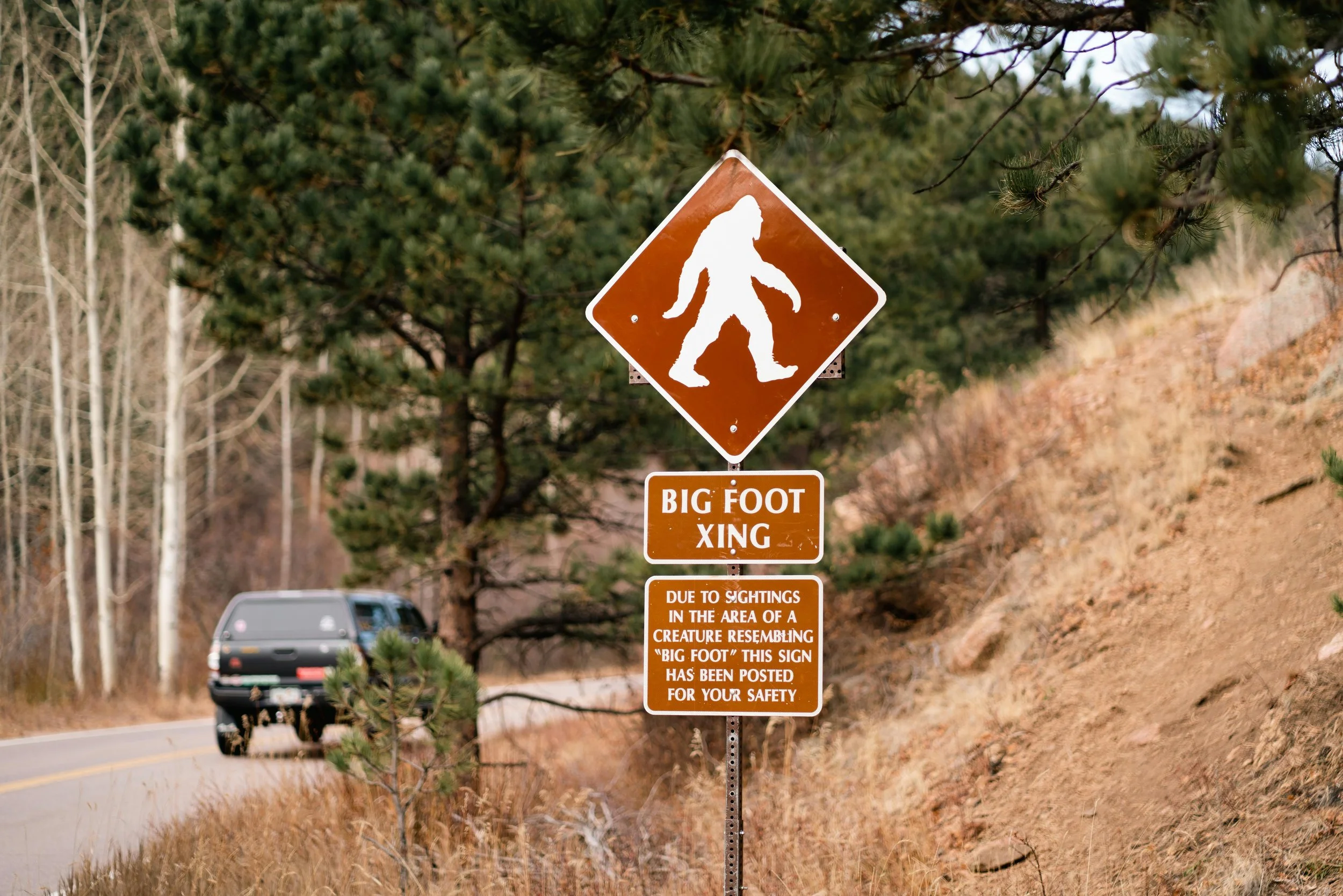Tales from the Cryptid Corner: When Curiosity Gets a Little Spooky
A Little Mystery Never Hurt Anyone
Every October, something strange happens.
The air cools down, the pumpkins appear, and children across the world start wondering: What’s out there? Maybe it’s just the wind through the trees… or maybe it’s Bigfoot taking an early evening stroll.
For parents, Halloween often feels like a balancing act — keeping things fun, not frightening; curious, not creepy. That’s where Wild Interest, the kids’ podcast made by kids themselves, finds its sweet spot. Its newest episode, “Tales from the Cryptid Corner,” invites young listeners (and their grown-ups) to explore the fascinating world of cryptids — creatures whispered about in campfire stories but never proven real.
Are they pure imagination? Evidence of something undiscovered? Or just stories we tell to make sense of what we can’t explain? As host Evan puts it, “A cryptid is a creature who’s rumored to be real, but whose existence has never been proven.”
It’s spooky, it’s scientific, and it’s absolutely perfect for Halloween.
Find out why people carve pumpkins into jack-o-lanterns on Halloween.
What Exactly Is a Cryptid?
Before your kids start searching the backyard for Mothman or peeking behind the couch for mermaids, it helps to understand what a cryptid actually is.
The term comes from cryptozoology — the study of hidden or unknown animals. These are creatures that haven’t been confirmed by science but have been spotted (or claimed to be spotted) by humans all over the world.
Bigfoot may be the most famous, but he’s far from alone. There’s the Abominable Snowman (or Yeti) in the Himalayas, Scotland’s elusive Loch Ness Monster, the thunderous Native American Thunderbird, and even the trickster Jackalope of American folklore.
What makes cryptids so compelling — especially for kids — is that they sit right at the crossroads of wonder and reason. They ask us to think like scientists and storytellers. What evidence do we have? What does it mean to “believe”? What counts as proof?
That’s the kind of curiosity Wild Interest thrives on.
The search for cryptids is fun, but no one has ever found one!
A Podcast Made by Kids, for Kids (and Listened to by Everyone)
Since its launch in early 2024, Wild Interest has built a global audience in more than 150 countries — no small feat for a show run by young hosts. With over 667,000 downloads, it’s found a loyal following among families who want screen-free entertainment that still feels modern, smart, and fun.
Each episode is produced and narrated by kids, with adults helping only on the technical side. The result feels organic and authentic — like overhearing an especially bright conversation at the kitchen table.
Co-hosts Nichole and Evan lead listeners through topics as wide-ranging as leap years, root beer taste tests, NFL football, and cultural holidays around the world. But their Cryptid Corner episodes, hosted by Evan, have become fan favorites.
“Evan’s Cryptid Corner” first aired in January 2024 and immediately struck a chord. As one young listener wrote, “It’s so interesting, and I love Cryptid Corner. Best podcast ever!!”
Parents agree. Another reviewer described the show as “overloaded with awesome,” praising its ability to mix jokes, real experts, and heartfelt storytelling.
That blend of humor, learning, and genuine warmth is exactly what makes the Halloween special such a standout.
Bigfoot sightings have been reported in North America for almost 75 years.
Inside “Tales from the Cryptid Corner”
The new episode is a sprawling adventure — a spooky, globe-spanning travelogue through myth and mystery. Evan invites back an old friend: Bobby the Bigfoot, a recurring guest who gives the legendary creature an affable, slightly skeptical voice.
The pair revisit cryptids from past episodes and add new ones to the roster. There’s the Yeti, thought by some to be Bigfoot’s chilly cousin; Mothman, who first appeared in Point Pleasant, West Virginia, in 1966; and even the elusive Tikbalang from the Philippines, a half-man, half-horse trickster said to lead travelers astray.
But the episode doesn’t stop there. Evan also interviews Dr. Jeff Meldrum, professor at Idaho State University and one of the world’s leading Bigfoot researchers. Their conversation dives into the science behind footprints, anatomy, and how legends evolve from misunderstood evidence.
Then comes one of the episode’s biggest surprises: a segment on UFOs — or, as Evan correctly notes, UAPs, short for Unidentified Anomalous Phenomena. He speaks with David Charles Grusch, a retired U.S. Air Force intelligence officer who’s investigated some of the most credible aerial sightings ever reported. Together they discuss what it means to “see something” and why humans are so drawn to mysteries that float just beyond explanation.
From there, the story zigzags through a gallery of global cryptids: monoliths that appear out of nowhere, mermaids in folklore and literature, and the massive, winged Thunderbird of Native American legend. It all culminates in a brand-new guest appearance by none other than Count Dracula — a playful nod to Halloween and the idea that even our scariest myths can teach us something if we look closely.
Spooky play is good for growing brains.
Why Kids (and Parents) Love the Spooky Stuff
At first glance, a Halloween episode about monsters might sound like pure entertainment. But for Wild Interest, the learning is baked in.
Each creature becomes a doorway to culture, geography, and science. When Evan talks about the Yeti, he’s also exploring Himalayan folklore and mountaineering history. When he discusses mermaids, he’s tracing oceanic myth across centuries and continents. And when Count Dracula enters the scene, he’s really inviting listeners to think about how stories evolve and what they reveal about human fears and hopes.
Parents often underestimate how much safe spookiness helps kids build emotional resilience. Psychologists note that age-appropriate scary stories can actually help children practice managing fear — a skill that’s essential for confidence and independence.
In Tales from the Cryptid Corner, that “safe scare” is delivered with humor and heart. Jokes, light banter, and clever sound design keep the atmosphere fun rather than frightening.
Evan’s co-host Nichole sums it up perfectly: “What makes us different is that we emphasize positive emotions like joy and curiosity. Our music is calm, and our segments are thoughtful. We want to leave kids feeling recharged instead of overstimulated.”
The Science of Listening (and Why Audio Still Matters)
In a world dominated by screens, Wild Interest offers something refreshingly analog: listening. When kids tune in, they’re not just being entertained — they’re training their brains to focus, imagine, and empathize.
Cognitive studies have shown that auditory storytelling engages different neural pathways than visual media. It strengthens memory, builds vocabulary, and encourages visualization — all crucial for developing reading and comprehension skills later on.
Host Evan describes it simply: “Our podcast is actually good for you! It’s brain broccoli, not brain candy.”
That philosophy — fun that feeds the mind — is woven throughout every Wild Interest episode. And for parents trying to balance screen time with enrichment, it’s a breath of fresh air.
How Curiosity Builds Connection
One of the most underrated aspects of the Wild Interest series is how it brings families together. Because the show is genuinely interesting for adults too, it’s become a popular companion for car rides, dinner prep, or bedtime wind-downs.
Parents report that episodes often spark big questions:
“Could Bigfoot really exist?”
“Why do people believe in UFOs?”
“How do scientists decide what’s real?”
Those questions don’t just make for fun dinner conversation — they model critical thinking. Kids learn to balance imagination with evidence, belief with curiosity.
That’s why Wild Interest has been described as “a wholesome alternative to video-based children’s entertainment.” Instead of bright lights and fast cuts, it cultivates depth — the kind of attention span and emotional engagement that’s increasingly rare.
Could creatures from other planets already be here on Earth?
From Campfire Stories to Classroom Science
What’s remarkable about Tales from the Cryptid Corner is how it connects folklore with real science. The show doesn’t tell kids what to believe; it teaches them how to think.
For example, when Dr. Meldrum discusses footprint analysis, Evan asks follow-up questions that model genuine scientific curiosity. How do you know a footprint isn’t a hoax? What tools do scientists use? What’s the difference between evidence and proof?
In another segment, the conversation about UFOs segues into a short, accessible explanation of how governments investigate aerial phenomena. The takeaway isn’t “aliens are real” — it’s that science begins with observation and open-mindedness.
That’s the balance Wild Interest strikes so well: wonder and reason, side by side.
The Halloween Connection
Beyond cryptids and creatures, the episode also celebrates Halloween itself — tracing traditions like pumpkin carving and trick-or-treating back to their origins in Celtic and early American customs.
There’s even a segment about a quirky St. Louis tradition: local trick-or-treaters have to tell a joke before receiving candy. It’s a charming reminder that laughter and community are at the heart of Halloween — not fear.
The episode’s mix of humor, history, and folklore makes it a rare kind of family content: something that delights kids and enriches parents at the same time.
Behind the Mic: How Wild Interest Gets Made
What most listeners don’t realize is how much care goes into every Wild Interest episode. The process mirrors a professional production studio, just scaled to fit young creators. Each episode begins with a brainstorm — a messy, energetic conversation about what’s caught the hosts’ attention lately.
Once a topic is chosen, the research begins. Kids read articles, watch documentaries, and even interview real experts. The team then writes and records their segments from home studios or local sound booths, where a parent or producer handles editing and sound design.
The editing style is tight but human. You can hear laughter, pauses, even the occasional stumble — all of which make the show sound genuine rather than polished to perfection. This authenticity has become one of the podcast’s secret strengths.
“Kids respond to other kids,” says producer Charlie Key. “When a child hears a peer asking smart questions, it gives them permission to be curious too.”
That sense of curiosity — and ownership — shines through in Tales from the Cryptid Corner.
Lessons Hidden in the Shadows
Every cryptid story is really about something deeper: the need to explain what we don’t understand. Bigfoot may represent our fear of isolation. The Loch Ness Monster could symbolize the vast unknown of the natural world. Even Dracula, for all his sharp edges, speaks to the timeless tension between fear and fascination.
Evan weaves these ideas together with a surprising sense of empathy. Instead of mocking believers or debunking legends, he treats each myth as a window into human imagination. Why do people across cultures invent monsters that live just out of sight? What do those stories say about us?
For kids, these questions open the door to critical thinking — but also compassion. They learn that not every mystery needs solving, and that sometimes, the journey to understanding is more rewarding than the answer itself.
“Whether Bigfoot is real or not,” Evan jokes, “I think it’s kind of awesome that people care enough to keep looking.”
Parents, Podcasts, and the New Digital Village
Parents today face an overwhelming landscape of content. Between screens, streams, and social media, finding something both safe and engaging can feel impossible. That’s why Wild Interest has become a word-of-mouth favorite among families looking for “the good stuff.”
Unlike passive entertainment, podcasts invite participation. Kids imagine scenes, ask questions, and discuss what they’ve heard. Many families report that episodes spark science projects, art activities, or even bedtime debates about whether the Mothman could survive in their backyard.
And because the show avoids ads for junk food, loud jump-cuts, or exaggerated cartoon voices, parents trust it. They know the creators value their children’s attention — and intelligence.
In an era when digital noise drowns out nuance, Wild Interest is building something rare: a quiet, connected, curiosity-driven community.
At its heart, Tales from the Cryptid Corner isn’t about monsters at all. It’s about the thrill of not knowing.
That feeling — the mix of excitement and uncertainty — is the same spark that drives scientific discovery. The greatest scientists, explorers, and inventors in history all began with the same question every kid asks at some point: “What if?”
By framing that curiosity through stories of mystery and myth, Wild Interest teaches children that curiosity itself is a form of courage. To wonder is to risk being wrong — but it’s also how we learn, grow, and connect with the world.
The best part? Kids don’t even realize they’re learning. They’re too busy laughing with Bobby the Bigfoot or whisper-gasps at Dracula’s surprise appearance.
Why Parents Keep Coming Back
Parents often describe Wild Interest as the rare podcast that grows with their kids. Because it never talks down to listeners, the show appeals to a wide age range — from early elementary to middle school and beyond.
Each episode layers simple takeaways for younger kids with deeper reflections for older ones. A five-year-old might just laugh at Bobby the Bigfoot’s jokes; a ten-year-old might catch the subtle commentary about belief and skepticism.
It’s also one of the few shows parents genuinely enjoy themselves. The humor lands, the writing respects its audience, and the sound design feels premium. It’s family media for families who value quality — not just quantity.
As one listener review put it, “Finally, a show that makes car rides quiet in the best way possible.”
Spooky goodies make Halloween fun!
Halloween as a Teachable Moment
Halloween is often seen as sugar and costumes, but Wild Interest treats it as an opportunity for connection.
In Tales from the Cryptid Corner, the holiday becomes a lens for exploring cultural traditions, storytelling, and imagination. The episode ends on a surprisingly tender note, reminding listeners that curiosity — like candy — is sweeter when shared.
Evan signs off with his trademark optimism: “Remember, not every mystery needs solving. Some just need exploring.”
For parents, that’s a message worth echoing. Curiosity, after all, is the spark that keeps families talking, learning, and laughing together.
The Broader Mission: Curiosity Without Chaos
Wild Interest isn’t chasing viral fame or screen addiction. Its creators are building a slow, steady brand of learning — one rooted in mindfulness, creativity, and connection.
Their guiding principle could be summed up as: Curiosity Without Chaos.
That means delivering stories that captivate without overwhelming. It means trusting children to think deeply, to ask questions, and to seek truth — even when the answers are mysterious.
In a media environment filled with overstimulation, Wild Interest is proof that calm storytelling still wins hearts.
How to Listen and Join the Adventure
New episodes of Wild Interest release regularly on Apple Podcasts, Spotify, and all major platforms. The show’s website features bonus materials — like art challenges, printable quizzes, and behind-the-scenes interviews — that turn each episode into a full sensory experience.
Parents can also sign up for the Wild Interest newsletter, which includes sneak peeks, educational activities, and family discussion prompts.
And for those who love the spooky side of learning, Tales from the Cryptid Corner is available now — a perfect listen for Halloween night or any curious afternoon.
A Final Word: The Magic of the Unexplained
If there’s a single takeaway from Tales from the Cryptid Corner, it’s this: mystery isn’t something to fear. It’s something to celebrate.
Whether or not Bigfoot is real doesn’t matter nearly as much as the fact that people keep looking — together. Because curiosity connects us. It makes us explorers, storytellers, scientists, and friends.
For parents seeking wholesome, thoughtful entertainment, Wild Interest proves that learning and laughter still belong in the same sentence. And for kids? It’s a reminder that even in a world full of answers, the best stories begin with a question.
So gather around. Dim the lights. Hit play.
Because sometimes, the best adventures happen when you listen.






